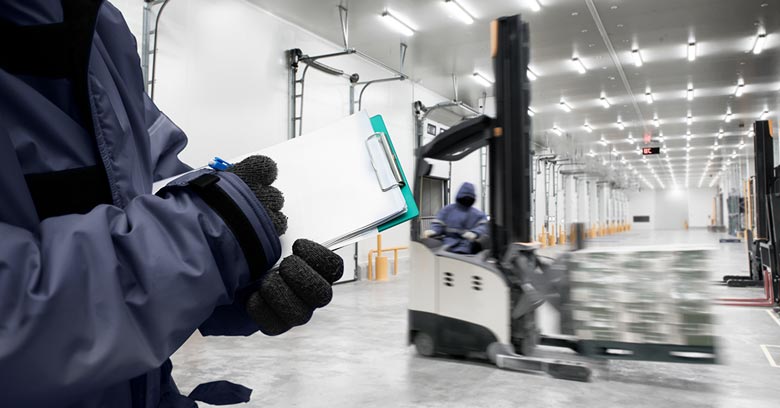
Vietnam’s cold storage market is expected to grow fast with booming demand, yet the growth is obstructed by a critical shortage of suppliers. The country is in urgent need of more cold storage centres with comprehensive services and centralized cold supply chains.
Cold Storage Warehouses
Cold storage warehouse, which is part of a cold chain, is a type of facility constructed with precise climatic conditions and additional maintenance to keep items safe at suitable low temperatures. Goods that are easily spoiled at normal room temperature and require cold storage are food, beverages, pharmaceuticals, chemicals, plants, and flowers. The tenants of cold storage warehouses are often third-party logistics companies, cold storage logistics specialists, or supermarket chains.
Vietnam’s Cold Storage Market
The cold storage industry is relatively new in Vietnam. Vietnam’s cold logistics is forecasted to reach a value of 295 million USD by 2025, with an exceptional growth rate of 12% per year. Despite a high projected growth rate, the market is nowhere near reaching its full potential. As of May 2021, Vietnam only had 48 cold storage warehouses with a capacity of about 700,000 pallets. Only 8.2% of domestic food manufacturers used cold chain systems, while export manufacturers accounted for 66.7% (2020).
Cold storage suppliers in Vietnam are mainly located in the Southern region. The market is more developed in the south because of high demand from seafood exports and retailers. Meanwhile, the Northern market witnessed an increase in warehouse capacity from 26,750 pallets (2015) to 71,750 pallets (2018).
About 60% of the market share is held by foreign investors, 14% by logistics companies and the remainder is held by members of the Vietnam Logistics Business Association, such as Transimex, Gemadept, and Saigon Newport.
Critical Shortage of Cold Storage
With 2020’s export turnover of agricultural products landing at 41.2 billion USD, Vietnam become the third-largest seafood exporter globally, which is the industry that occupies the largest share of cold storage. However, the current capacity of Vietnam’s cold storage warehouses only meets 30-35% of the nation’s demand for preserving seafood, agricultural products, and fresh food. By the end of 2019, the filling capacity of domestic cold storage had already reached 80%.
The cold storage supply shortage situation has been worsened by the Covid-19 pandemic. During the peak of the pandemic, 30-50% of seafood export orders were cancelled and raw seafood that needed to be stored at low temperatures could not leave the country. Consequently, the congested goods filled up a large share of the cold warehouses, and the remainder of the country’s cold storage capacity could not meet the demand. Additionally, during the long period of lockdowns, locals were restricted from visiting supermarkets, and instead turned to e-commerce or online shopping for fresh food. To keep the delivered groceries fresh for the consumers, more and more sellers turned to distributors with refrigeration to handle their products. This shift in consumer behaviour added more pressure to the limited cold storage operators. As the available warehouses are already operating at full capacity, the market is witnessing a surge in rent prices; cold storage rents in southern Vietnam stood at 87 USD per ton in Q4/2021, up 167% from Q1/2020.
Problems With Cold Storage in Vietnam
Aside from the effects of the pandemic, one of the main causes of the supply shortage is the costly initial investment required to build and maintain a cold storage warehouse. The construction of one requires special equipment, continuous inspections, and far more electricity than other logistics facilities. Some cold storage warehouses are twice to three times more expensive to build than a conventional warehouse. In addition, the construction time is often longer – from 6 months, up to one year, and the lease term usually lasts from 15 years to 20 years, making supply even more scarce. Therefore, despite long-term benefits, businesses without strong financial support hesitate to build and operate cold storage. In Vietnam, some large corporations invest in their storage systems, yet small and medium-sized companies are dependent on the overcrowded rental market.
The scarcity of cold storage has posed multiple risks for Vietnam’s agricultural product export. Seafood export businesses need cold storage not only to store products purchased from farmers that will later be distributed to retailers, but also to keep a safety stock of products to serve unexpected surges in demand. The extreme cost of logistics caused by the abnormal surge in cold storage rents has made these businesses struggle to operate. Many businesses cannot afford the high cost, thus, they are hesitant with their purchases as they are unsure whether they can meet the demand or not.
Investment Opportunities
The strong projected growth in demand reveals a lot of opportunities for new cold storage suppliers. Vietnam’s large population, high urbanization rate, a booming trend in online shopping, and rapid growth of the middle class, have led to increased orders on high-quality fresh food, which will only further drive the need for cold storages.
Improved exports infrastructure following the construction of Long Thanh International Airport and trade agreements, it is predicted that the global demand for Vietnamese seafood will be on the rise in upcoming years. The new free trade agreement between Vietnam and the EU (EVFTA) also helps to amplify the growth as the EU is the largest importer of Vietnamese seafood (23%).
Growing demand for cold storages show a promising future for potential suppliers, but there is still room for improvements in the existing network of cold storages. There is a lack of measures that fully ensure safe and efficient service, the supply chains are decentralized, and the market mostly consists of small and medium-sized warehouses. Therefore, the country is not only in urgent need of more big cold warehouse suppliers, but also of more cold storage centres with comprehensive services and a centralized network.
Read more about our market entry and expansion in sector or our other consulting services.
The insights provided in this article are for general informational purposes only and do not constitute financial advice. We do not warrant the reliability, suitability, or correctness of the content. Readers are advised to conduct independent research and consult with a qualified financial advisor before making any investment decisions. Investing in financial markets carries risks, including the risk of loss of principal. Past performance does not guarantee future results.
The views expressed herein are those of the author(s) and do not necessarily reflect the company's official policy. We disclaim any liability for any loss or damage arising from the use of or reliance on this article or its content. ARC Group relies on reliable sources, data, and individuals for its analysis, but accuracy cannot be guaranteed. Forward-looking information is based on subjective judgments about the future and should be used cautiously. We cannot guarantee the fulfillment of forecasts and forward-looking estimates. Any investment decisions based on our information should be independently made by the investor.
Readers are encouraged to assess their financial situation, risk tolerance, and investment objectives before making any financial decisions, seeking professional advice as needed.



